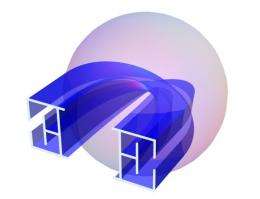The art of invisibility and the perfect cat's eye

(PhysOrg.com) -- In recent years scientists have explored the impossible by developing invisibility or 'cloaking' devices, but can the same technology also help make things more visible?
Using the science of invisibility, a team from National University of Singapore, Masaryk University and the University of St Andrews have come up with a singular solution: the perfect cat's eye.
Cat's eyes shine when they are caught in the light of cars, and appear to glow in the dark. A mirror positioned at the back of a cat's eye reflects light back to its source - back towards the car's headlights. This works well for light from some angles, but not for all.
Physicists have wondered whether it would be possible to design a cat's eye that could reflect light from every angle. Finding that this was something that couldn't be done with mirrors, researchers turned to the science of singularities.
An optical material like glass changes the speed of light and may change its direction. At a singularity, the speed of light should appear to become infinite or zero, and waves travel infinitely slow or infinitely fast - which seems to be impossible. However, according to a concept by Tomas Tyc from Masaryk University and Ulf Leonhardt from the University of St Andrews, it can be done.
Using 'transformation optics', one of the latest fields of optical science and the key to the creation of invisibility devices (put forward by Leonhardt and Sir John Pendry of Imperial College in 2006), the physicists were able to transmute the singularity into something more practical.
Professor Leonhardt said "Singularities are the curses of physics. Like the curse of the wicked fairy godmother in Sleeping Beauty, they cannot be taken back, but they can be altered with some pure and applied magic, aka science. We achieved this for optical singularities - and it worked remarkably well."
Yun Gui Ma and CK Ong from National University of Singapore, closely collaborating with Tyc and Leonhardt, built a perfect omnidirectional retroreflector for microwave radiation. The instrument is able to reflect images and create high visibility from all directions, as the team writes in the journal 'Nature Materials'. Microwaves, used for wireless technology, mobile phones and radar, are electromagnetic waves like light, but with a much longer wavelength.
The scientists believe that with further development, the same technology could also work for light waves. The perfect cat's eye may soon help you to be seen wherever you are and from whatever angle.
Provided by University of St Andrews


















